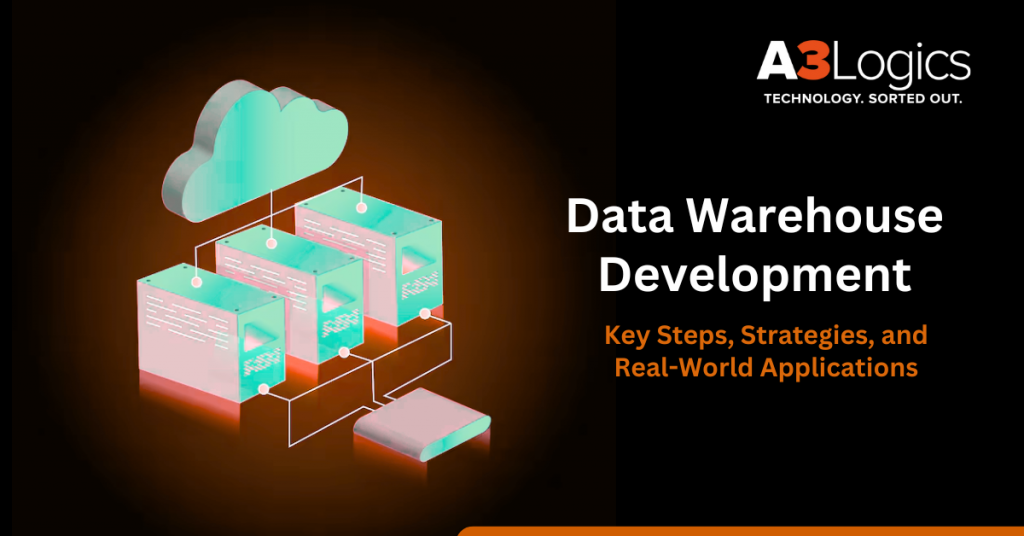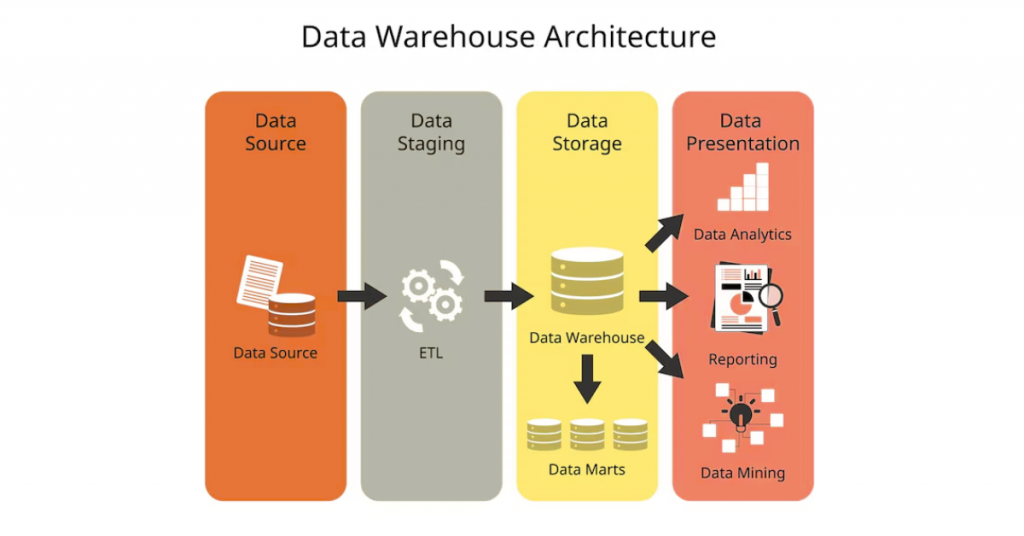| Summary of Data Warehouse Development: Do you make business choices using spreadsheets or siloed databases with non-standard structures and formats? Do you see inconsistencies in data between business units? Do you have difficulty choosing on permissions and access levels for limited company data? In this blog, we discuss how to build a data warehouse, whether you need one or not, benefits of data warehouse, and simple steps to ensure a successful data warehouse implementation. |
Modern businesses are drowning in data. According to IDC research, the global datasphere is expected to reach 175 zettabytes in 2025. Data has emerged as the primary driver of technology innovation and corporate intelligence. Data warehouse development, or the process of collecting, storing, and managing data from various sources, has developed from a simple storage solution to a strategic asset that drives software innovation.

As organizations generate unprecedented amounts of data – the tactics they use to store this information have become significant differentiators in operational efficiency and competitive advantage.
A data warehouse is a centralized system that stores and manages massive amounts of data from multiple sources. It is intended to assist organizations understand historical data and make informed decisions. Data from various operating systems is – collected, cleansed, and stored in an organized manner, allowing for efficient queries and reporting.
The goal is to generate statistical results that can help with decision-making. Ensuring quick data retrieval, even with large datasets. In this comprehensive blog on how to build a data warehouse we have taken a look at the keysteps, strategies and the real-world applications of data warehouse for businesses.
Table of Contents
Why Your Business Needs a Data Warehouse?
Businesses of today understand the importance of leveraging data. In order to store this data, data warehouse development plays a key role. In this section we will take a look at the business value of data warehouse implementation:

1. Centralized Data Storage
Perhaps the most immediate and significant advantage of a data warehouse development is centralized data storage. In most organizations, data is dispersed across many systems—CRM systems, ERP systems, financial software, marketing automation systems, and so on.
A data warehouse collates all this information into a single source of truth, with stakeholders able to view integrated information without having to switch systems. This integration dispenses with data silos and enhances collaboration across departments. Thanks to the fact that everybody is working with the same dataset.
2. Time-Saving Data Retrieval
Manually extracting data from various systems takes too much time and is prone to errors. A data warehouse implementation simplifies the process. It does this by providing quick, efficient data retrieval. Through automated processes and structured data pipelines, business users can run reports and dashboards within minutes—not hours.
This time-saving benefit gives decision-makers real-time information and quicker response times. Whether monitoring daily sales, campaign performance, or demand forecasting, having access to accurate data on demand is a major competitive advantage.
3. Fewer Manual Errors
Manual data entry and report generation heighten the risk of human error. The risks include duplicate records, improper formatting, inconsistent naming conventions, and outdated information can all compromise business decisions.
Proper data warehouse development reduces manual intervention by using automated data extraction, transformation, and loading ETL processes. Not only does this enhance efficiency – but it also preserves the integrity of your data.
4. Structured and Consistent Data Availability
Unstructured or inconsistent data makes it hard to derive reliable insights. A data warehouse architecture imposes standardization and consistency on all datasets. It standardizes data formats, definitions, and metrics so that all departments interpret and utilize data in the same manner.
For instance, if “customer churn” is defined differently by operations and marketing teams, then it creates confusion. In data warehouse development, these definitions are standardized and formalized so that insights become dependable and replicable. Such consistency is particularly useful for regulatory reporting, performance measurement, and corporate reporting.
5. Automation in Data Management
Data warehouse development facilitates automated – data ingestion, transformation, and reporting, diminishing the need to depend on IT or data engineering teams for regular tasks. With the data flows in place, the system is able to retrieve new data automatically. They then clean it, update the warehouse, and refresh reports or dashboards without the need of any human intervention.
This automation allows –
- Scalability: Effortlessly manage increasing data amounts as your company grows.
- Efficiency: Allocate less time for preparing data and more time analyzing it.
- Productivity: Release precious time for teams to work on strategic projects.
Cloud data warehouse – like Snowflake, Amazon Redshift, and Google BigQuery make automation even easier with capabilities such as real-time data streaming, serverless computing, and native connectors.
6. Unified Data Security Framework
Data governance and security are high on the agenda for organizations of all sizes. A data warehouse enforces a centralized and uniform security policy across your data landscape. This includes
- Role-based access control (RBAC)
- Data encryption at rest and in transit
- Audit logs for monitoring user activity
- Compliance with regulations (GDPR, HIPAA, etc.)
Rather than having to manage permissions for dozens of tools, companies can enforce consistent policies from a single point. This minimizes the risk of data breaches, unauthorized access, and compliance issues.
Additionally, cloud data warehouse usually have enterprise-level security tools built-in, which makes them a more secure choice than running on-prem infrastructure.
Core Components of Data Warehouse Architecture

Lets breakdown of the foundational data warehouse components of data warehouse architecture:
> Data Source Layer
The data source layer collects data from all internal and external sources. It makes the data available for processing in the staging layer.
Different data sources have unique business and data processing cycles, geographical characteristics, network and hardware resource constraints, and so on. So, it’s impossible to collect data from all the sources at once.
Source data can come from web browsers, IoT devices, social media, internal applications, external databases, and so on.
> Data Staging Layer
The data staging layer extracts data from the source layer and saves it in a temporary database using the Extract, Transform, and Load (ETL) method. It also identifies schema and structure, cleanses, formats, and tests the data.
Depending on the methodology used, this layer may not be required in some cases if the ETL process is handled by the storage layer.
> Data Storage Layer
The data storage layer hosts the data warehouse database for company-wide information. It also enables the hosting of data marts, which are subsets of your data warehouse and contain data unique to business areas. Ensuring data availability to end users.

Approaches to Data Warehouse Development
Data warehouse development consists of various methodologies. In this section we will take a look at them with their pros and cons:
> Top-Down Approach (Inmon Methodology)
Bill Inmon introduced the Top-Down Approach, a method for data warehouse development that begins with the creation of a centralized data warehouse for the entire firm. This central repository serves as the single source of truth – for data management and analysis throughout the company. It maintains data consistency and establishes a solid platform for decision making.
How Does it work:
Central Data Warehouse: The process begins with the creation of a comprehensive data warehouse that collects, integrates, and stores data from several sources. This requires the ETL (Extract, Transform, Load) procedure to clean and transform the data.
Specialized Data Marts: Once the central warehouse is constructed, smaller, department-specific data marts (for example, finance or marketing) are built. These data marts access information from the primary data warehouse, guaranteeing consistency across departments.
Top-Down Approach: Pros and Cons
| Pros | Cons |
| Consistent Dimensional View | High Cost and Time-Consuming |
| Improved Data Consistency | Complexity |
| Easier Maintenance | Lack of Flexibility |
| Better Scalability | Limited User Involvement |
| Enhanced Governance | Data Latency |
| Reduced Data Duplication | Data Ownership Challenges |
| Improved Reporting | Integration Challenges |
| Better Data Integration | Not Ideal for Smaller Organizations |
> Bottom-Up Approach (Ralph Kimball Methodology)
The Bottom-Up Approach, popularized by Ralph Kimball, is a more flexible and gradual approach to data warehouse development. Instead of starting with a single data warehouse, it first creates small, department-specific data marts to meet the urgent needs of different teams, such as sales or finance. These data marts are later combined to build a more comprehensive, unified data warehouse.
How does Bottom-up Approach work
Department-Specific Data Marts. The process begins by developing data marts for individual departments or business processes. These data marts are intended to suit departments’ urgent data analysis and reporting requirements, allowing them to acquire quick insights.
Integration with a Data Warehouse: Over time, these data marts are linked and combined to form a single data warehouse. The connection assures consistency and gives the business a comprehensive picture of its data.
Bottom-Up Approach: Pros and Cons
| Pros | Cons |
| Faster Report Generation | Inconsistent Dimensional View |
| Incremental Development | Data Silos |
| User Involvement | Integration Challenges |
| Flexibility | Duplication of Effort |
| Faster Time to Value | Lack of Enterprise-Wide View |
| Reduced Risk | Complexity in Management |
| Scalability | Risk of Inconsistency |
| Clarified Data Ownership | Limited Standardization |
> Hybrid Approach
The Hybrid Approach combines elements of both the Top-Down (Inmon) and Bottom-Up (Kimball) methodologies of data warehouse development. This model is increasingly adopted by organizations seeking both strategic structure and rapid deployment. It allows businesses to start with data marts for immediate results while simultaneously building or integrating a central enterprise data warehouse.
How Does the Hybrid Approach Work?
Parallel Development: Organizations can start by creating data marts for urgent business needs while concurrently planning or constructing the central data warehouse.
Integrated Layer: Data from department-specific data marts is later harmonized and connected with the enterprise warehouse using metadata or master data management practices to ensure consistency.
Scalable Structure: Over time, as business needs evolve, data marts and warehouses are aligned into a unified architecture.
Hybrid Approach: Pros and Cons
| Pros | Cons |
| Balance of Speed and Structure | Requires Strong Governance |
| Faster Time to Value | Complex Data Integration |
| Flexibility in Implementation | Potential Duplication of Logic |
| Scalable and Adaptive | High Maintenance Overhead |
| Combines Strategic and Tactical Benefits | Challenging Metadata Management |
| Encourages Business-IT Collaboration | Can Be Difficult to Standardize |
| Supports Both Immediate and Long-Term Goals | Requires Skilled Resources |
> Federated Approach
The Federated Approach is a decentralized methodology of data warehouse development where data remains distributed across multiple autonomous systems but is virtually integrated through middleware or data virtualization technologies. Unlike traditional methods, it doesn’t rely on physically moving or storing data in a centralized warehouse. Instead, it allows for real-time or near real-time access and analysis across data sources.
How Does the Federated Approach Work?
- Virtual Integration Layer: A middleware or virtualization tool sits on top of various source systems and presents a unified data view to users.
- No Physical Warehouse Needed: Instead of consolidating data, it accesses it directly from source systems during query time.
- Autonomous Systems: Each data source maintains its own data model, structure, and governance, and is not dependent on a central system.
Federated Approach: Pros and Cons
| Pros | Cons |
| Minimal Data Redundancy | Performance Issues with Large Queries |
| Real-Time Data Access | Limited Historical Data Analysis |
| Lower Initial Investment | Complex Security and Governance |
| High Flexibility | Difficult to Ensure Data Consistency |
| Easy to Implement Across Multiple Systems | Lack of Centralized Control |
| Useful for Dynamic, Fast-Changing Data | Integration Tools Can Be Costly |
| Supports Agile Environments | Limited Analytical Capabilities |
Industry Use Cases of Data Warehousing
Data warehouse development services empowers each industry with streamlined operations, better decision making and data-driven insights.
1. Fintech
In the fintech industry data warehouse development has the following use cases.
> Customer Data Integration
In the fintech arena, customer data tends to be dispersed across platforms like mobile apps, online websites, CRM software, and transactional databases. A data warehouse consolidates all this scattered information into one location, allowing financial institutions to view each customer through a 360-degree lens. This enables targeted services, fraud detection, and customized financial products.
> Risk Analytics
Risk management is critical in fintech. Data warehousing enables firms to analyze historical data patterns, credit scores, and market trends to assess customer creditworthiness or predict default risks. Real-time data feeds integrated into a warehouse also support ongoing monitoring of financial risks, such as exposure to market volatility or regulatory non-compliance.
> Insight Generation
By aggregating transaction records, usage behavior, customer interactions, and market data, fintech businesses are able to make important business insights. Such insights aid in maximizing product offerings, discovering investment patterns, and increasing customer satisfaction by data-driven decision-making.
2. Travel & Hospitality
In the travel and hospitality industry data warehouse development has the following applications.
> Booking & Reservation Data
A data warehouse integrates booking information from websites, travel agencies, mobile apps, and partner networks. It provides a consolidated view to track occupancy levels, predict demand, and control inventory across hotel chains or airline networks. It supports strategic planning of pricing, promotions, and resource allocation on the basis of real-time and historical trends.
> Housekeeping & Operational Data
Operational efficiency is crucial in hospitality. Data warehouses consolidate housekeeping schedules, maintenance logs, personnel, and power consumption into a global view of hotel or resort operation. This allows real-time monitoring of room availability, predictive maintenance, and optimized staffing management to improve the guest experience.
> Guest Profile Management
Hospitality and travel companies leverage data warehouses to store detailed guest profiles consisting of preferences, history of stays, feedback, and loyalty participation. This enables custom experiences, spearheaded marketing, and VIP-level service, strengthening brand allegiance and improving customer retention.
3. Retail
Data warehouses have an important role to play in the retail and ecommerce industry, here are some of the major use cases of data warehouse development.
> Demand Forecasting
Retailers utilize data warehouses to gather and analyze sales patterns, seasonal information, and regional purchasing behavior. This facilitates precise demand forecasting, which aids in inventory optimization, reducing stockouts or overstock situations, and enhancing supply chain efficiency.
> Customer Behavior Analysis
Data warehousing allows collation of customer interaction information across mobile applications, e-commerce sites, in-store visits, and loyalty schemes. The data is analyzed by retailers to identify purchasing habits, product interests, and engagement patterns. These are used to drive targeted promotions, product suggestions, and better customer segmentation.
> Business Intelligence Reporting
Merchants use data warehouses to create real-time and planned reports on KPIs like sales performance, product turnover, store efficiency, and campaign ROI. Integrated dashboards and visual analytics enable decision-makers to make rapid adjustments in strategies, spot new opportunities, and track organizational performance by location and channel.
How to Build a Data Warehouse: Step-by-Step Guide?
Data warehousing offers vast opportunities to various businesses. Here are the data warehouse development steps on how to build a data warehouse.
1. Requirement Gathering & Analysis
This data warehouse development steps aim at defining business goals, sources of data, and user requirements. Stakeholders work together to determine what information is required, how it would be utilized, and compliance or security issues. The outcome is a comprehensive requirement document that the data warehouse architecture and development process follows.
2. Architecture Design
This phase specifies the technical data warehouse architecture. It documents data flow, storage technology, system elements, and integration methods. The objective is to develop a scalable, secure, and efficient environment that can serve immediate needs but enable future expansion and flexibility.
3. Selecting the Correct Technology Stack
Opting for proper tools and platforms is critical in terms of performance and scalability. This encompasses databases, ETL tools, BI software, data engineering services and cloud services. The stack must be compatible with business requirements, cost, and current IT infrastructure to enable smooth implementation and maintainability in the long run.
4. ETL Development (Extract, Transform, Load)
ETL includes extracting data from different sources, converting it to a clean and normalized form, and loading it into the warehouse. This keeps the data consistent, of good quality, and ready for reporting and analysis, and is the operational foundation of the data warehouse.
5. Data Modeling
Data modeling organizes the warehouse for speedy querying and reporting. It involves creating fact and dimension tables, establishing relationships, and grouping data in a manner that maps to business logic. Proper modeling guarantees rapid performance, data consistency, and ease-of-use analytics features.
6. Testing and Validation
This stage guarantees the correctness, reliability, and security of the data warehouse. It entails data quality validation, ETL process testing, and user acceptance testing. The objective is to identify and correct any errors prior to going live to guarantee trust in the final system.
7. Deployment & Ongoing Maintenance
After successful testing, the warehouse is deployed for production use. Maintenance includes monitoring performance, updating ETL workflows, managing data growth, and adapting to new requirements. Continuous support ensures the system stays efficient, secure, and aligned with evolving business goals.

Cost Considerations in Data Warehouse Development
While each data warehouse is unique in its own way, it is difficult to assign a fixed cost to establish one. Typically, for data warehouse development, the following elements influence the data warehouse cost:
Infrastructure (Cloud vs On-Premise)
Cloud offerings are more flexible and have lower upfront investment but with ongoing usage fees. On-premise deployments entail massive upfront investments in hardware and physical infrastructure.
Software Licensing (DB, ETL, BI Tools)
Database, ETL tool, and BI platform software licensing can be very different. Open-source tools can reduce costs, while enterprise-grade solutions entail subscription or licensing fees.
Data Storage & Transfer Costs
Data warehouse cost depend on data volume, storage class (hot vs. cold), and frequency of data transfer—especially for cloud environments where data egress charges become applicable.
Development & Implementation Costs
Architecture customization, ETL pipeline creation, and dashboard build require man-hours. These are a function of the project size, complexity, and development team size.
Maintenance & Support
Recurring data warehouse cost include system maintenance, performance tracking, bug patches, and user support. Internal IT support or managed services both come under this expense.
Scaling Performance
With growing data, one requires more storage as well as processing resources. Scaling up the infrastructure or performance optimization can come under long-term data warehouse cost.
Security & Compliance Expenses
Adding encryption, access controls, auditing, and compliance with standards (e.g., HIPAA or GDPR) both requires technology investment as well as staff.
Training & Change Management
Giving employees the capability to use the new system and managing organizational change requires training programs, documentation, and support in transition.
Key Benefits of a Data Warehouse
Data warehousing is critical for modern data management, as it provides a stable framework for enterprises to consolidate and strategically analyze data. Benefits of data warehousing provide businesses with the tools they need to make informed decisions and derive useful insights from their data.
1. Unified Access to Enterprise Data
A data warehouse integrates data from multiple departments, systems, and sources into one repository. This unified access breaks data silos and provides users throughout the organization with access to consistent and complete data, facilitating collaboration, transparency, and a 360-degree view of the business.
2. Improved and Faster Decision-Making
With timely, well-organized, and centralized data at their disposal, decision-makers can make quick and confident decisions. The easy access to reliable data facilitates quicker responses to internal operations, customer requirements, and market changes, enabling businesses to remain competitive and agile.
3. High-Quality Datasets
Data warehouses implement standardization by cleaning, validating, and organizing incoming data. This allows all users to work on consistent, reliable datasets—eliminating errors, eliminating confusion, and enhancing the accuracy of reports, dashboards, and analytics.
4. Faster Reporting and Analytics
By keeping data in an optimized format, data warehouses support quicker query processing and report runs. Business users can get pre-aggregated or real-time data without delayed processing, accelerating analysis and allowing teams to make better decisions more quickly.
5. Historical Data Tracking and Trend Analysis
In contrast to transactional databases, data warehouses store high amounts of historical data. The benefits of data warehousing allow organizations to monitor performance over time, recognize trends, track KPIs, and predict future results based on patterns—enabling strategic planning and predictive analytics.
6. Enhanced Data Governance and Security
A centralized warehouse enables organizations to have uniform data governance policies. Access controls, encryption, audit trails, and tools for data lineage improve data security and compliance. It’s easier to monitor who is accessing what data and how it’s being consumed as well.
7. Less Manual Intervention
Automated ETL, standardized processes, and self-service BI decrease manual data preparation and repetitive work. This saves time for analysts and IT staff to work on more valuable tasks and minimizes the risk of human error.
8. Capable of Handling Future Business Growth
Data warehouses are built to grow with business requirements. When data volumes rise and new sources are introduced, the system is able to accommodate expansion without negatively affecting performance. This scalability makes it possible for long-term value and flexibility in response to changing business needs.
About A3Logics
A3Logics is a reliable technology partner with expertise in next-generation data analytics services and data warehouse services. Having years of experience, we enable organizations to realize the complete value of their data with contemporary, scalable, and secure designs.
Our expert team of data engineers, architects, and analysts provides end-to-end solutions—right from requirement gathering and ETL design to performance tuning and maintenance. Whether you are upgrading legacy systems or constructing a new warehouse ground-up, A3Logics guarantees data speed, accuracy, and reliability to inform better decisions and long-term business growth.
Take a deeper look at the Types of Data Warehouse to find the one that suits your business needs the most.

Conclusion
A data warehouse is more than simply a technology tool; it represents a strategic opportunity for data-driven corporate growth. With proper strategy, implementation, and use, your firm may leverage the power of structured data to outperform competition and achieve goals.

![Best Practices For Enterprise Software Development Outsourcing in the USA [2025]](https://www.a3logics.com/wp-content/uploads/2024/03/New-Project-6.webp)

![20 Best Healthcare App Development Companies [2024-2025]](https://www.a3logics.com/wp-content/uploads/2023/10/20-Best-Healthcare-App-Development-Companies-2023-2024.webp)

